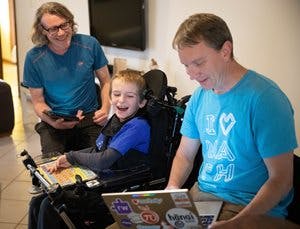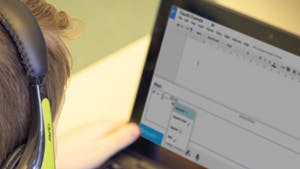Giving a voice to MathematiCAL thinking from the Australian Outback
Meet Callaghan (Cal) Shepherd, a 10-year-old self-confessed maths nerd who was introduced to EquatIO for the first time this week.

John McGowan, our EquatIO Product Manager was visiting Australia and was excited to be able to meet with Cal to introduce the power of EquatIO to a fellow maths nerd.
The fact that Cal was wearing his favourite t-shirt printed with Pi mathematical constants and a neck scarf displaying the Periodic Table of Elements when John and I arrived, definitely set the tone for the meeting!
I first met Cal when he was just three years old. In my role as an occupational therapist supporting independent use of assistive technologies by students with disabilities, I was fortunate to be able to facilitate a presentation by his parents, Megan and Grant, at the Inclusive Learning Technologies Conference in 2012 in Australia. They shared that Cal had choreoathetoid Cerebral Palsy quadriplegia resulting from a lack of oxygen at birth. They expressed their commitment to ensuring that Cal had a voice to share his personality and intelligence with all around him, also showcasing his achievements at the time on the family’s YouTube Channel.
Now, at 10 years of age, Cal still has no voice. Well, no spoken voice that is. But that does not mean he doesn’t have a lot to say. He uses both high-tech and low-tech tools to communicate. He had a lot to say back when he was three years old, but now he has so much more to say, particularly around his favourite topic of mathematics. According to Grant, “Cal could immerse himself in maths 24/7!”
His leisure hours are happily spent watching the science and maths-focused Numberphile and Vsauce YouTube channels, in between having fun adventuring in Minecraft. Even his jokes are all around maths and he has a lot of them to share.
Maths-savvy
Cal’s discussion with John explored the impact on parabolas of variables, number sequences, tangrams, the power of the Sigma function, Thales Theorem, magic squares, the Leaning Tower of Lire, and the use of Latex to publish maths in peer-reviewed journals! I’ll admit the less maths-savvy adults in the room (me included) were regularly Googling to find out more about many of the maths concepts that Cal was so excited to be sharing with John.
This is a whole lot of maths for anyone to cover in two hours, let alone a 10-year-old. So, it was easy to see why he had recently been recognized as a gifted and talented student and accelerated to secondary schooling, a year ahead of his age-group peers.
Expressing maths independently
The problem facing Cal is that he needs a way of expressing his maths knowledge independently, without relying on a third party like his Teacher Aide or his parents to try to interpret what he is saying. This is particularly critical as his level of maths competence surpasses that of many of those supporting his communication.
EquatIO, in combination with customised grids set up using the Grid 3 on his Surface Pro computer and two buttons (called switches) mounted in his wheelchair headrest, means that Cal is at the early stages of being able to independently show what he knows mathematically.
The fact that Cal can now access the tools he needs to create digital maths means that he is not only equipped to communicate with his family and his school, but also with the wider maths community worldwide. Given that Cal lives in Broken Hill, a city quite literally in the Australian Outback and a solid 15-hour drive west from Sydney into the desert, this opens up many unopened doors for his future!
John’s thoughts after the meeting?
“I was astounded by the maths knowledge that Cal possessed. He got such joy out of using the Tangrams, counting rods, and other shapes in the EquatIO mathspace. Giving him a virtual version of these physical manipulatives empowered him to show his thought process in new ways. He loved to build representations with them and to try to connect them to the sequences that he loves to make algebraically.”
Cal’s thoughts on his first experiences with EquatIO?
Apart from his obvious pure enjoyment of all things maths made possible via EquatIO, he shared that he thought, “It will help me to develop mathematical sequences and theorems. In the future I want to code too.” He also then grinned and launched into a joke for us before we left. “Two mathematicians walk into a bar ...”


